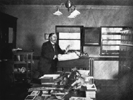
|
Since its inception, the University of Pennsylvania Museum
has supported a strong program of research and excavation in the Mediterranean
world. Highlights include an emergency underwater excavation of a shipwreck
off Porticello, Italy, (dating between 415 and 385 B.C.); the Greek colony
of Sybaris, Italy (founded around 720 B.C.); the settlement and surroundings
of Vrokastro, Crete (Middle Minoan, with a reoccupation from about 1250
B.C. to the 7th century B.C.); the city and cemeteries of Kourion, Cyprus
(Late Bronze Age into the Hellenistic and Roman periods); a merchant vessel
shipwreck off Kyrenia, Cyprus (4th century B.C.); Gordian, Turkey (132k),
once ruled by the famed King Midas (Early Bronze Age into the Roman period);
and the Extramural Sanctuary of Demeter and Persephone at Cyrene, Libya
(ca. 600 B.C. until the mid third century A.D.). These projects all belong
to the Greek Iron Age (ca. 1050 B.C. to 323 B.C.), the period represented
in this overview. |

|
Because of strict laws governing the export of archaeological
material from its country of origin, very few of the artifacts from these
excavations are in the Museum's collections or on display. Exceptions
are the large body of archaeological material from Kourion which with
the permission of the Department of Antiquities of Cyprus is a part of
the Museum's collections, and the material from Vrokastro, Crete (116k),
acquired by the Museum through a permit from the Greek government at the
time of excavation. A Middle Minoan to Bronze Age site, excavated in 1910
to 1912, has been restudied and surveyed from 1977 to the present.
Instead, the majority of the objects on display came to the University
of Pennsylvania Museum through generous individual donors. From the earliest
days of the Museum, benefactors such as John Wanamaker, Phoebe A. Hearst
and Lucy Wharton Drexel provided funds to purchase collections of painted
Greek pottery and Classical sculpture, the founding collections of the
Mediterranean Section. |

|
Other Greek objects were donated by family members of individuals
who formed idiosyncratic collections around the end of the 19th and beginning
of the 20th century. Maxwell Sommerville (198k), appointed the first Professor
of Glyptology at theUniversity of Pennsylvania in 1894, left a collection
of over 2,500 Classical engraved gems. Hermann V. Hilprecht (182k), Curator
of the Babylonian Section and director of the Museum's first expedition
at Nippur from 1889 to 1898, collected bronze figurines from Turkey and
elsewhere. William Nickerson Bates, a Classicist at ehe University of
Pennsylvania from 1895 to 1939, amassed a fine collection of Greek pottery
and other artifacts. The Philadelphia siblings John T. and Lydia T. Morris
were typical Victorian travelers with eclectic tastes. Most of the Museum's
finest Greek coins come from John Morris's collection of ancient coins
and glass. William Sansom Vaux's collection of Greek and Roman glass and
early travel photographs from the Mediterranean were collected in the
19th century and presented to the Museum as a gift by his great-nephews,
George and Henry J. Vaux. |
 |
As a result of political changes in the world and strict
international export regulations for antiquities, it is for the most part
no longer possible or ethical for individuals or museums to amass new
collections of Classical antiquities. The focus of the Mediterranean Section's
curatorial work is, thus, the care of the collections already entrusted
to us and their use for study and research and for the edification and
pleasure of the public. |




